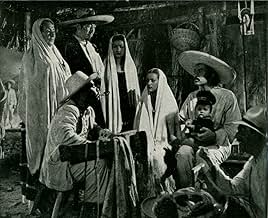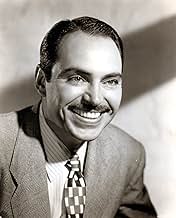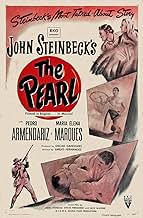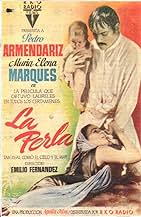IMDb रेटिंग
7.4/10
1.2 हज़ार
आपकी रेटिंग
अपनी भाषा में प्लॉट जोड़ेंThe discovery of a perfect pearl forever changes the lives of a poor Mexican fisherman and his family.The discovery of a perfect pearl forever changes the lives of a poor Mexican fisherman and his family.The discovery of a perfect pearl forever changes the lives of a poor Mexican fisherman and his family.
- पुरस्कार
- 9 जीत और कुल 6 नामांकन
José Arratia
- Tratante de perlas
- (बिना क्रेडिट के)
Guillermo Calles
- Indio rastreador
- (बिना क्रेडिट के)
Enrique Cancino
- Pueblerino
- (बिना क्रेडिट के)
Maria Elena Cuadros
- Juanita
- (बिना क्रेडिट के)
Columba Domínguez
- Pueblerina
- (बिना क्रेडिट के)
Enedina Díaz de León
- Yerbera
- (बिना क्रेडिट के)
Agustín Fernández
- Pueblerino
- (बिना क्रेडिट के)
Rogelio Fernández
- Pueblerino
- (बिना क्रेडिट के)
Raquel García
- Pueblerina
- (बिना क्रेडिट के)
फ़ीचर्ड समीक्षाएं
10whpratt1
Some how I over looked this John Steinbeck brief story years ago and loved this 1947 production and the fantastic acting. The film is great in black and white and it clearly shows the poverty of local fishermen and their hard tasks of having to dive only when the ocean was calm. Pedro Armendariz,"From Russia With Love",'63 and Maria Elena Marques,"Pueblilo",'62, gave an outstanding performance as husband and wife who have to deal with finding a great treasure and having to face the hard facts of many people who want to share their wealth. Charles Rooner,(Doctor),"Silent Fear",'56 plays a very horrible doctor who seems to hate the local fishermen and wants to treat only the rich who will be able to pay his medical fees. This is truly a great film, which was very well produced and a great Film Classic from the late 40's. Enjoy
The Pearl is directed by Emilio Fernández and John Steinbeck co-adapts his own novella of the same name with Fernández and Jack Wagner. It stars Pedro Armendariz, María Elena Marqués, Fernando Wagner, Gilberto González, Juan García and Charles Rooner. Music is by Antonio Díaz Conde and cinematography by Gabriel Figueroa.
We are in La Paz, Mexico, and when Quino and Juana's son is stung by a scorpion the couple are anguished by not having the finances to pay for medical treatment. Hope springs eternal when Quino discovers a large pearl, something which is seemingly the answer to their prayers - is it?
What we basically have here is a morality play about the corruption of greed. Once the pearl of the title is discovered the ugliness of mankind rears its vile head. People around Quino and Juana - a homely honest but poor couple - suddenly have designs on the financial gains that the pearl can bring - with some of them willing to commit cardinal sins to achieve their aim. The pearl also begins to drive a wedge between the loving couple, and thus we are held enthral of the story to see exactly where this will all end up?
Though it's not very subtle in the telling, with Steinbeck's literary bent often as heavy as a sledgehammer, this is undeniably compelling stuff. That it's also a visual delight also considerably aids the viewing experience. Fernández and Figueroa bring truly atmospheric cinematography into play as a key character of the piece, with kinked frames and low level shots perfectly embracing the discord of the troubling human conditioning on view. Come 1947 what we would come to know as the film noir style of film making was in full effect, fans of such should for sure add The Pearl to their must seek out lists. 8/10
We are in La Paz, Mexico, and when Quino and Juana's son is stung by a scorpion the couple are anguished by not having the finances to pay for medical treatment. Hope springs eternal when Quino discovers a large pearl, something which is seemingly the answer to their prayers - is it?
What we basically have here is a morality play about the corruption of greed. Once the pearl of the title is discovered the ugliness of mankind rears its vile head. People around Quino and Juana - a homely honest but poor couple - suddenly have designs on the financial gains that the pearl can bring - with some of them willing to commit cardinal sins to achieve their aim. The pearl also begins to drive a wedge between the loving couple, and thus we are held enthral of the story to see exactly where this will all end up?
Though it's not very subtle in the telling, with Steinbeck's literary bent often as heavy as a sledgehammer, this is undeniably compelling stuff. That it's also a visual delight also considerably aids the viewing experience. Fernández and Figueroa bring truly atmospheric cinematography into play as a key character of the piece, with kinked frames and low level shots perfectly embracing the discord of the troubling human conditioning on view. Come 1947 what we would come to know as the film noir style of film making was in full effect, fans of such should for sure add The Pearl to their must seek out lists. 8/10
I am a Brit happily married to a Mexicana for many years and lived in Mexico for a number of years.
La Perla is a photographic masterpiece of significant beauty and well worth seeing for the magnificence of the incredible use of natural light to highlight the scenery.
In addition to the two main stars the cast contains a number of actors whose work I have enjoyed immensely and the scenes depicting the singing and dancing at the local fiesta bring back to me countless memories of pleasure during my life in that beautiful country.
This film really does reflect the Golden Years of the Mexican Fim Industry.
La Perla is a photographic masterpiece of significant beauty and well worth seeing for the magnificence of the incredible use of natural light to highlight the scenery.
In addition to the two main stars the cast contains a number of actors whose work I have enjoyed immensely and the scenes depicting the singing and dancing at the local fiesta bring back to me countless memories of pleasure during my life in that beautiful country.
This film really does reflect the Golden Years of the Mexican Fim Industry.
Making an adaptation off John Steinbeck's short novel wasn't easy and always a feat.But Emilio Fernandez and Gabriel Figueroa did it in a succesful way.
Pedro Armendariz repeats on a high class of acting role as in 'Maria Candelaria'. Once again the cinematography of Gabriel Figueroa ranks among the best he's done. (the cinematography of this movie earned him, a prize at the Cannes Film Festival).
The aid of Mr. Steinbeck himself, helped Emilio to adapt the screenplay just as good as the novel itself.
This movie has no flaws and it ranks among the best in Mexico Film History, a must see.
Pedro Armendariz repeats on a high class of acting role as in 'Maria Candelaria'. Once again the cinematography of Gabriel Figueroa ranks among the best he's done. (the cinematography of this movie earned him, a prize at the Cannes Film Festival).
The aid of Mr. Steinbeck himself, helped Emilio to adapt the screenplay just as good as the novel itself.
This movie has no flaws and it ranks among the best in Mexico Film History, a must see.
Apparently this piece is uncomfortable for people who simplify into moralism its complexity and forcefulness in what it has to say both explicitly and implicitly, aspirationism for wealth and the discord and greed it provokes, bourgeois class robbery of the working class, colonialist extractionism, whiteness as a jewel that gives privilege, all this as true then as it still is, set in a melodrama full of anguish, plus of course a beautiful montage in which the photography and the masterful underwater sequences stand out, marvellous at the time and which stand the test of time with great neatness.
क्या आपको पता है
- ट्रिवियाEmilio Fernández, who was in love with Olivia de Havilland, thought she was the ideal actress to play the female starring role. De Havilland never knew of his secret love, but the director was able to get the government of Mexico City to change the name of the street he grew up on to "Dulce Olivia" (Sweet Olivia).
- भाव
Narrator: This is a story that old men tell to children. They aren't sure where it happened or when.
- इसके अलावा अन्य वर्जनA short version (77') was shown in the USA, France and West Germany whereas a longer version (85 to 87') was shown in Mexico and East Germany.
टॉप पसंद
रेटिंग देने के लिए साइन-इन करें और वैयक्तिकृत सुझावों के लिए वॉचलिस्ट करें
- How long is The Pearl?Alexa द्वारा संचालित
विवरण
- चलने की अवधि1 घंटा 25 मिनट
- रंग
- पक्ष अनुपात
- 1.37 : 1
इस पेज में योगदान दें
किसी बदलाव का सुझाव दें या अनुपलब्ध कॉन्टेंट जोड़ें

























